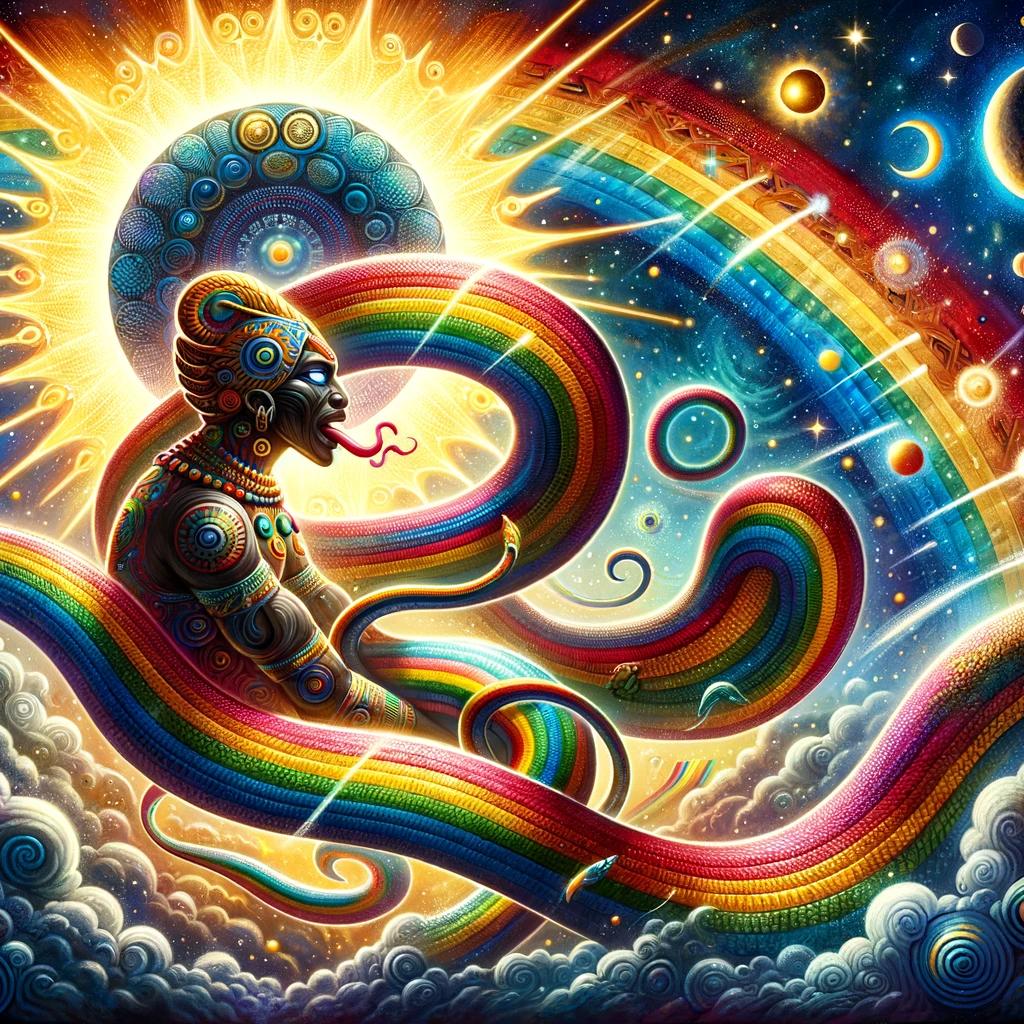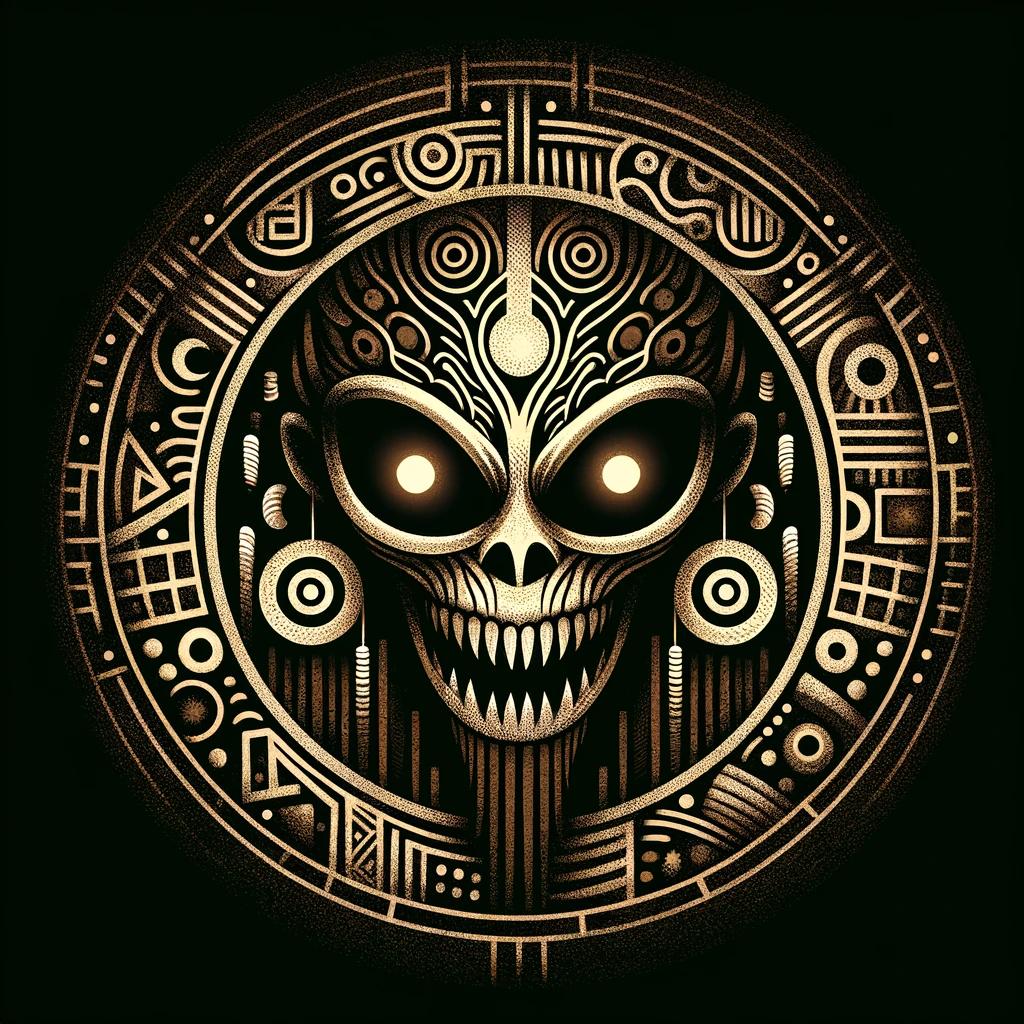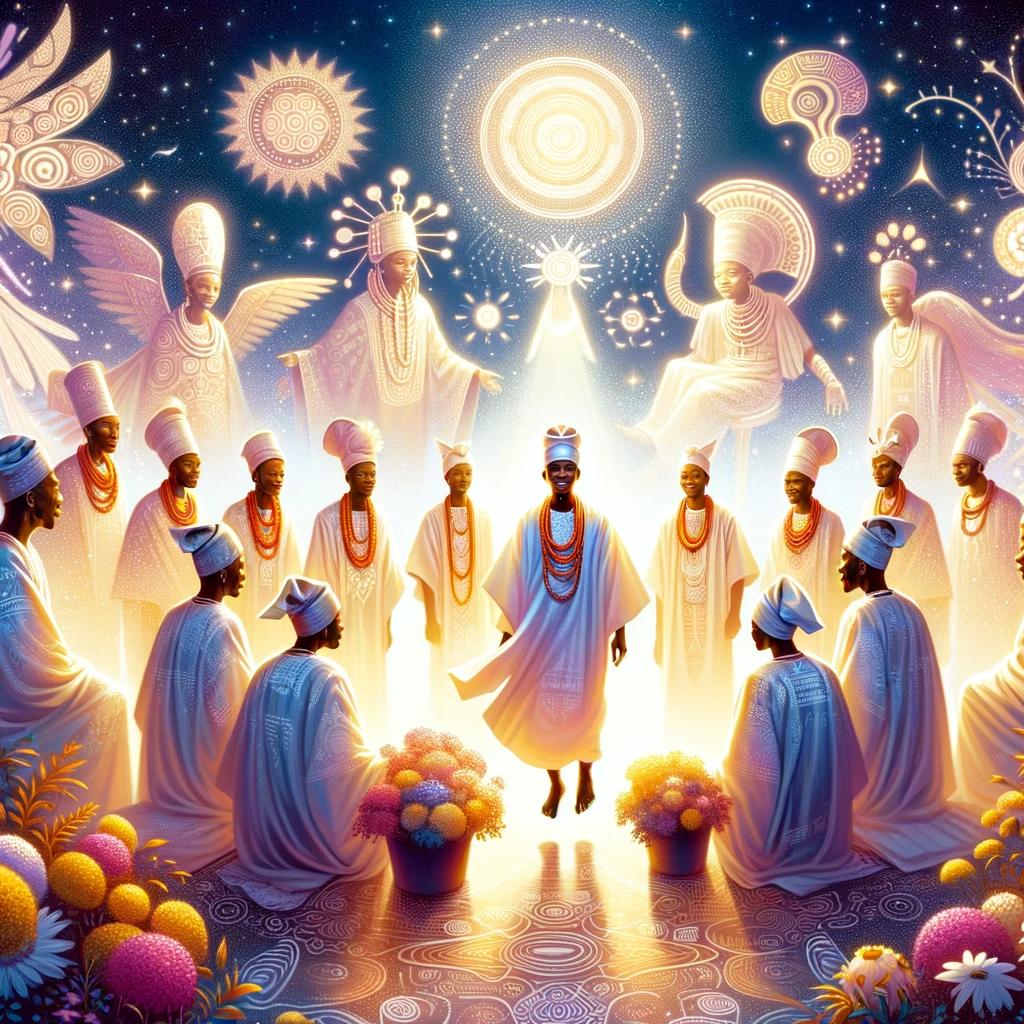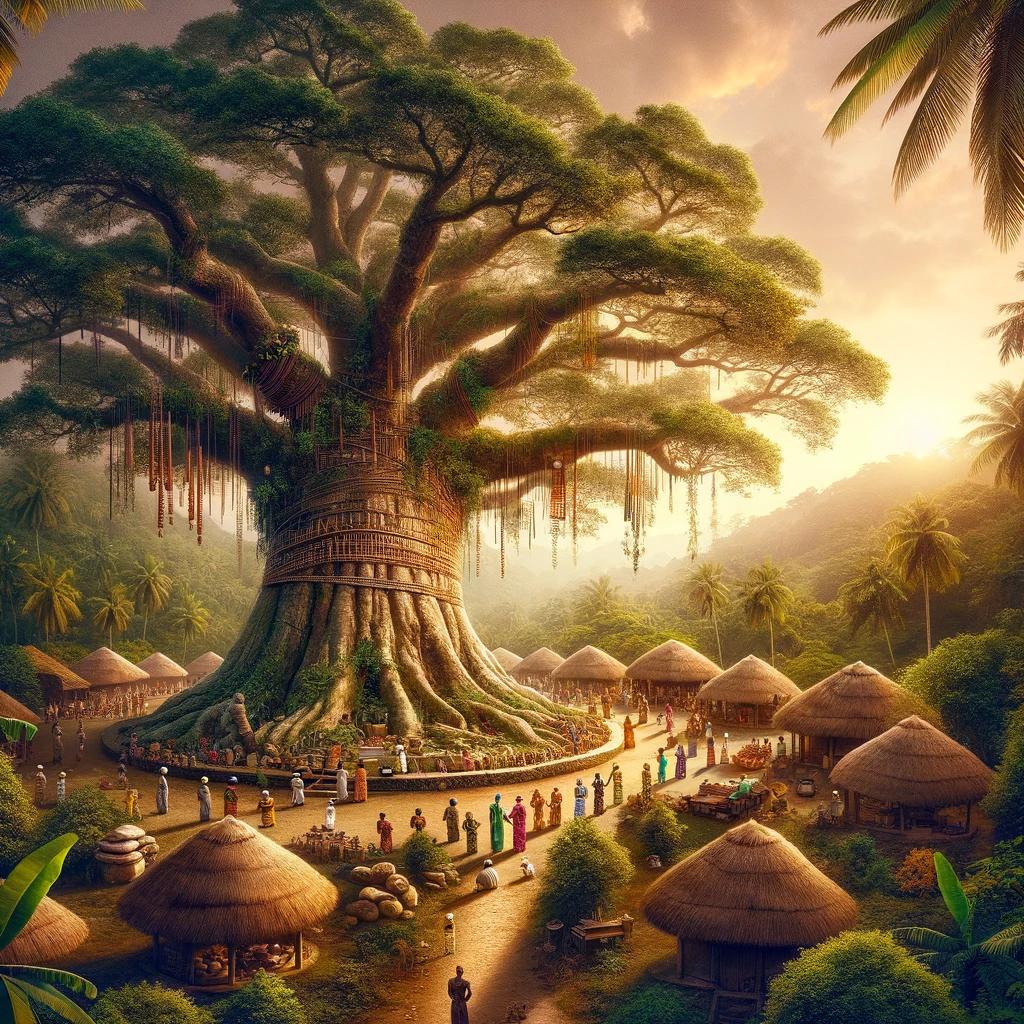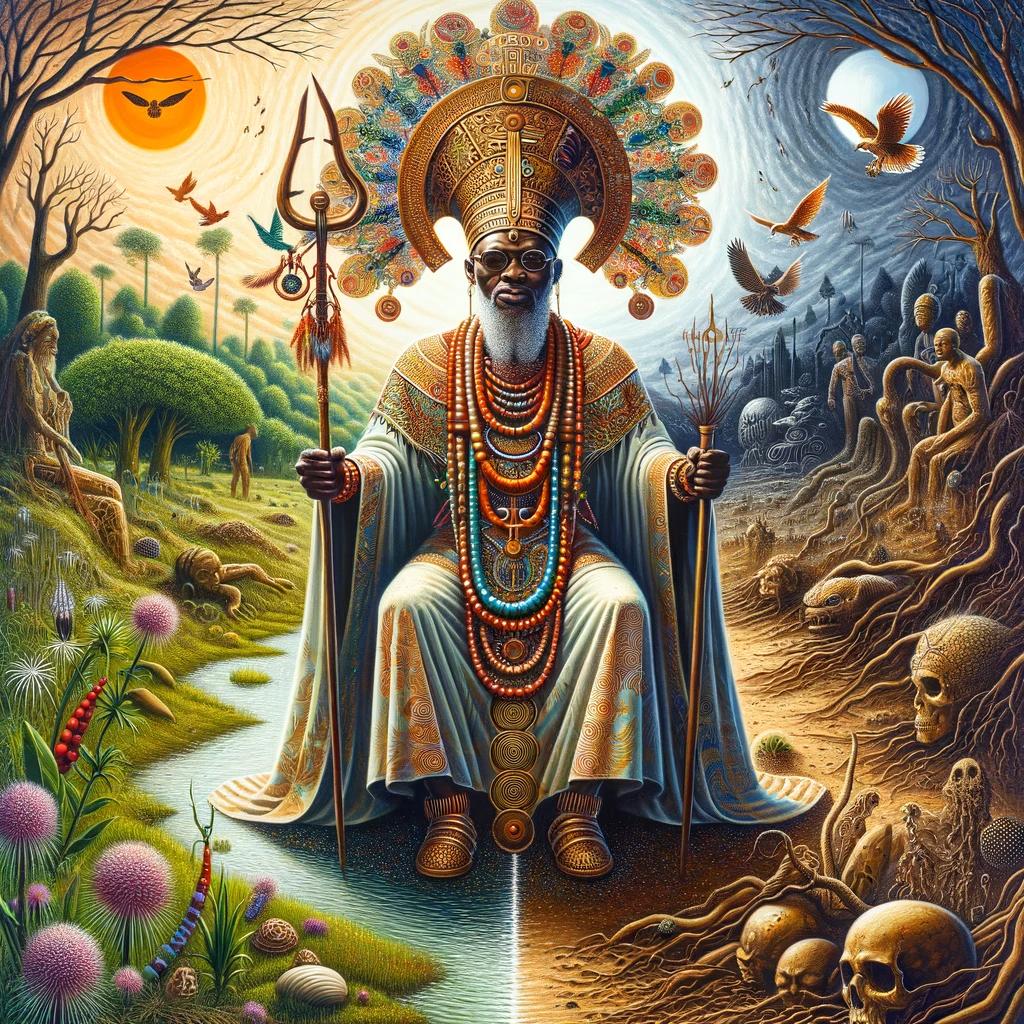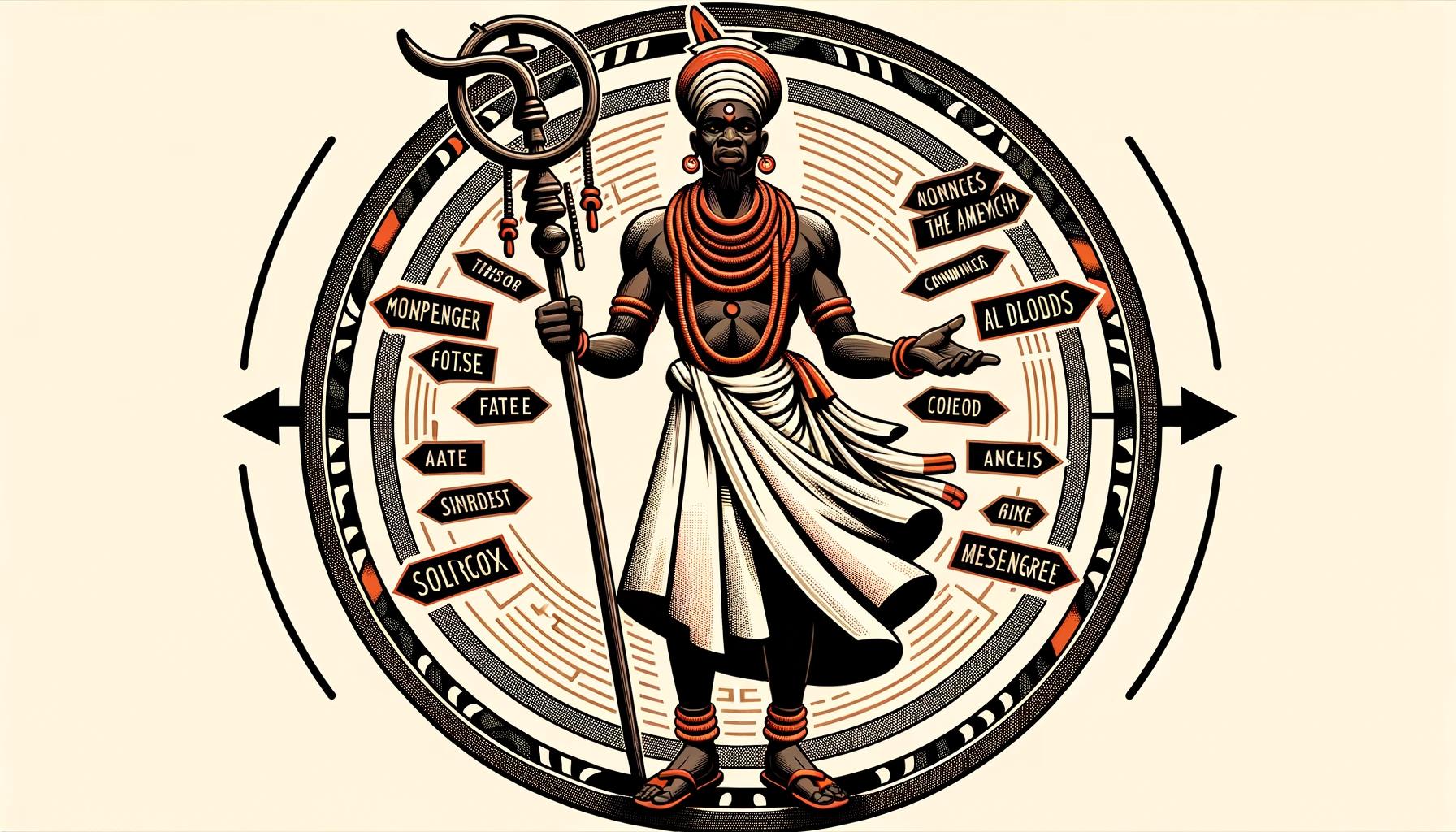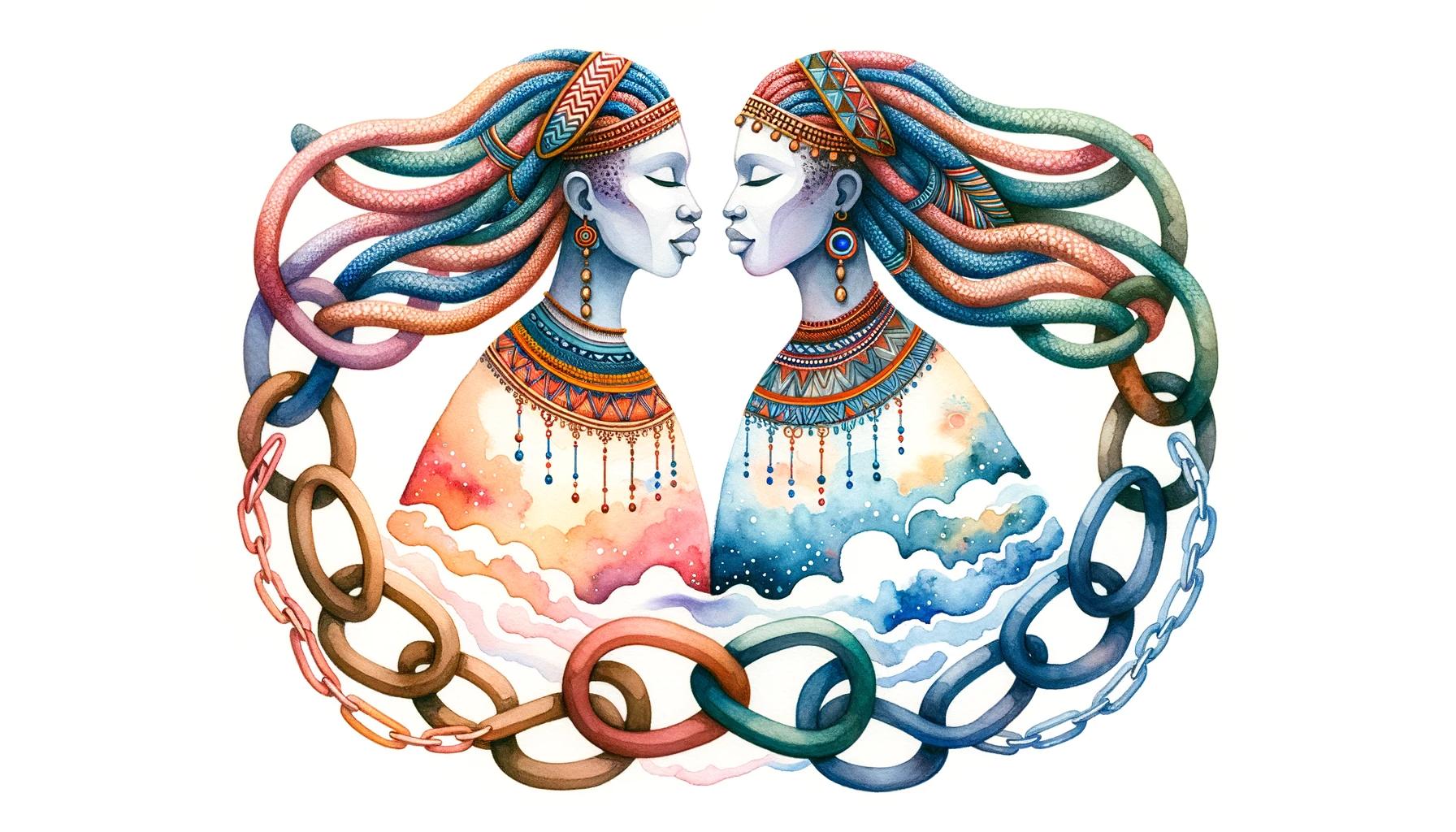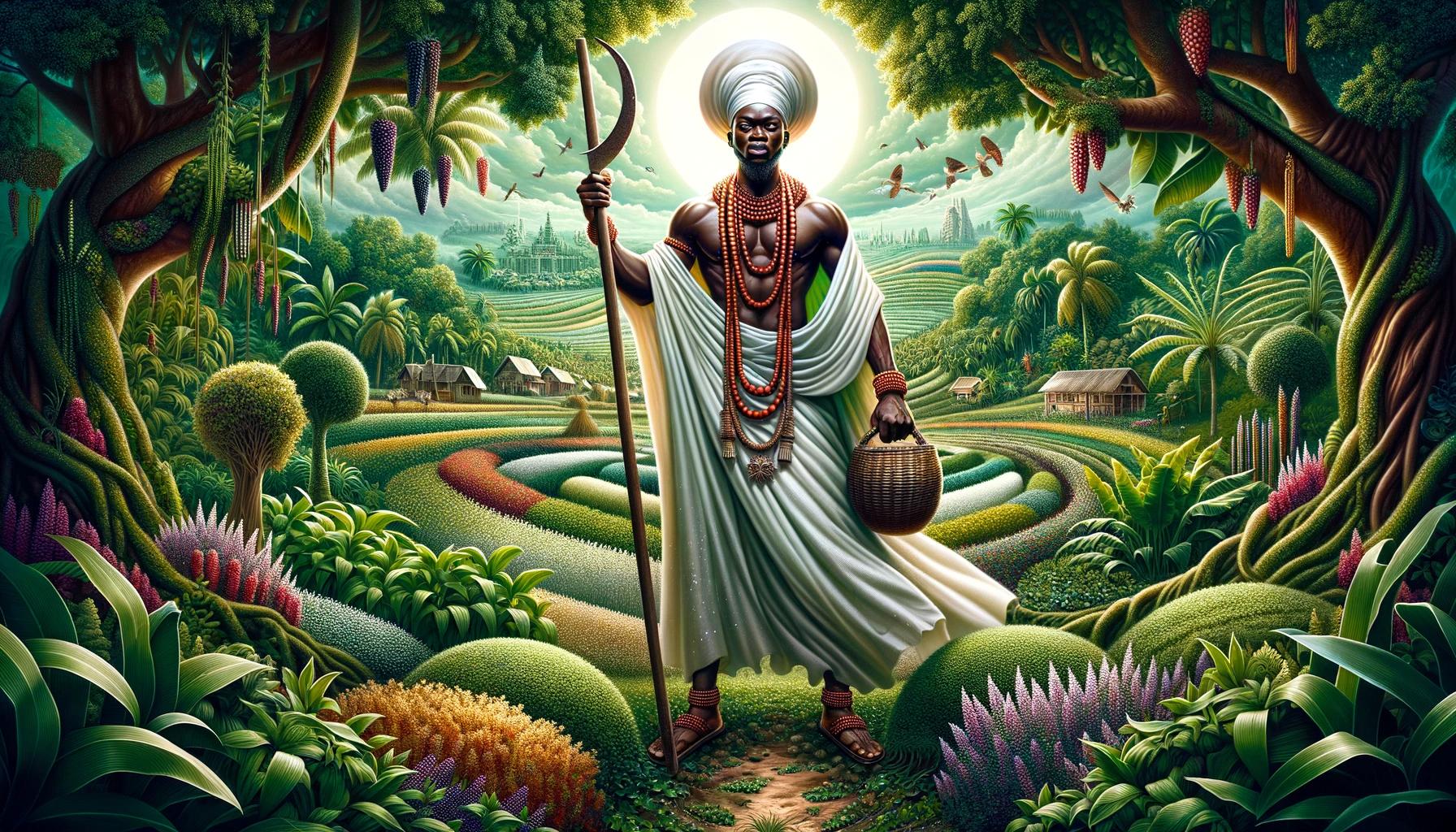‘Oya African Goddess of Storms: Unveiling the Power and Majesty’
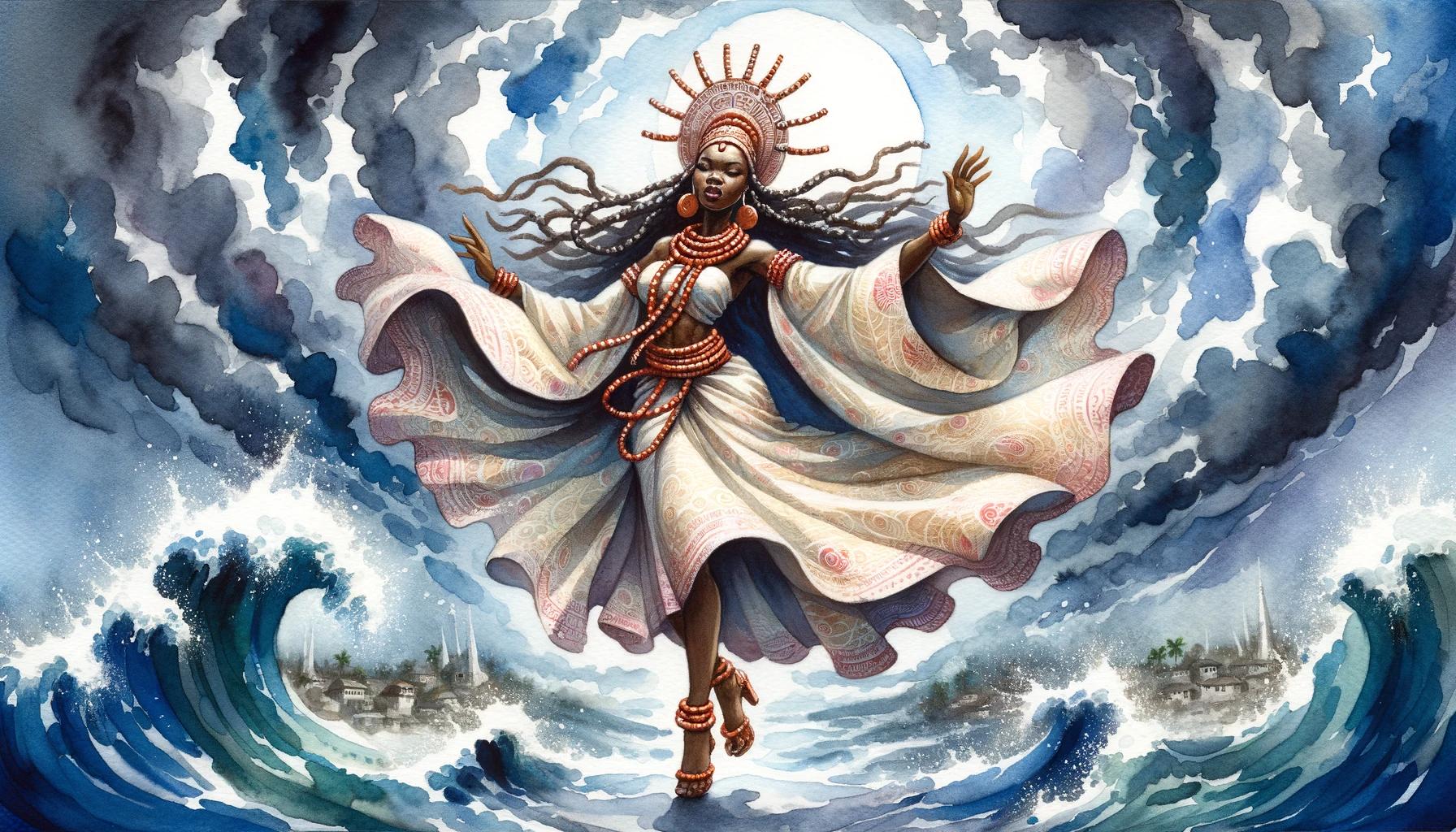
Oya, the African goddess of storms, holds an esteemed place in Yoruba mythology and culture. Revered for her association with weather and natural phenomena, Oya is a powerful figure known for her ability to bring about transformation and destruction.
She is also worshipped in other African spiritual traditions such as Santeria, Candomble, and Vodou. Oya’s influence extends beyond Africa, leaving a lasting impact in literature, media, and the beliefs of present-day worshippers.
This article provides an overview of Oya’s significance, exploring her mythology, associations, and legacy in African religions.
Overview of Oya African Goddess of Storms
Welcome to the fascinating world of Oya, the African goddess of storms. In this section, we will explore the essence and significance of this powerful deity within African mythology and religious traditions.
Oya is revered as a force of change, transformation, and destruction, commanding the winds, lightning, and storms.
Oya’s origin can be traced back to Yoruba mythology, where she is considered a prominent deity.
She is believed to be the daughter of Obatala, the god of creation, and Yemaja, the goddess of the sea. Additionally, Oya is known as the favorite wife of Sango, the thunder and lightning god.
Symbolizing both the awe-inspiring might of nature and the essence of feminine power, Oya is often depicted as a fierce warrior. Armed with a sword or machete in one hand and a fan in the other, she holds the ability to control the winds, unleash storms, and cut through obstacles with her sword.
Her influence extends far beyond the Yoruba people and their culture. Oya is also venerated in other African spiritual traditions such as Santeria, Candomble, and Vodou. In these traditions, she embodies the spirit of storms and embodies the power of transformation.
Throughout history, Oya’s captivating presence has found its way into literature, art, and media. She has been portrayed as a powerful and independent woman, as well as a seductive and cunning character.
As we delve deeper into this article, we will explore Oya’s beliefs, mythology, and her role in Yoruba religion and other African spiritual traditions. We will also examine her associations with weather and natural phenomena, her transformative nature, and her portrayal in various cultural expressions.
Join us on this journey to unravel the intriguing world of Oya, the African goddess of storms.
Beliefs and Mythology Surrounding Oya
The beliefs and mythology surrounding Oya, the African goddess of storms, hold great significance in Yoruba religion and culture. She is deeply revered for her immense power over the elements and her connection to transformative forces.
Oya is believed to be the daughter of Obatala, the god of creation, and the favorite wife of Sango, the god of thunder and lightning. According to Yoruba mythology, she emerged from the union of Yemaja, the goddess of the sea, and Obatala. This divine lineage highlights Oya’s importance and her association with natural phenomena.
In Yoruba belief, Oya is often depicted as a fierce and powerful warrior, armed with a sword or machete in one hand and an fan in the other. It is said that her fan has the ability to control winds and unleash storms, while her sword is used to cut through obstacles and bring about change.
Oya’s control over the rain brings nourishment and fertility to the earth, making her a symbol of abundance and growth.
She is also believed to possess the ability to transform the lives of individuals.
Oya is seen as a catalyst for personal growth and spiritual evolution. Her role as a goddess of change makes her a figure of empowerment, inspiring people to embrace transformation and overcome challenges.
While Oya is deeply rooted in Yoruba culture, her influence extends to other African spiritual traditions such as Santeria, Candomble, and Vodou. In these traditions, she is associated with the spirit of the storm and the power of transformation, embodying the forces of nature that can bring both destruction and renewal.
Throughout history, Oya’s mythology and symbolism have been celebrated in various forms of literature and media. She has been portrayed as a strong and independent woman, a seductress, and even a trickster in different portrayals.
Her multifaceted nature and her ability to evoke powerful emotions have made her a compelling figure in storytelling.
Today, Oya’s legacy continues to be honored and worshipped by many, both in Africa and beyond.
Her spiritual presence and the belief in her transformative power serve as a source of inspiration and guidance for those seeking growth and change in their lives.
Oya in Yoruba Religion and Culture
In the vibrant tapestry of Yoruba religion and culture, Oya holds a significant place as a revered deity.
She is deeply intertwined with the beliefs, rituals, and mythology of the Yoruba people. Oya is regarded as one of the most powerful goddesses, embodying the forces of nature and playing a pivotal role in the Yoruba pantheon.
As the goddess of storms, Oya is entrusted with the domain of wind, lightning, and thunder. In Yoruba cosmology, she is seen as both a destroyer and a creator, embodying the cycle of life and death.
Oya’s presence is often associated with transformation and change, reflecting the ever-fluid nature of existence.
The Yoruba people honor Oya as a warrior figure, representing strength, courage, and fierce determination. She is often depicted with a sword or machete in one hand, symbolizing her ability to cut through obstacles and bring about transformation.
In her other hand, she holds an abanico, a fan that is believed to have control over the winds and storms, showcasing her dominion over the elements.
Oya’s influence extends beyond the forces of nature.
She is recognized as a guardian of the ancestral realm and is believed to have the power to connect with ancestral spirits. Her role in Yoruba religious ceremonies and rituals is crucial, as she serves as an intermediary between the human and divine realms.
Devotees seek her guidance and protection, particularly during times of transition and personal transformation.
In Yoruba cosmology, Oya plays a significant role in the divine trinity alongside her husband, Sango, the god of thunder and lightning, and Yemaja, the goddess of the oceans and motherhood.
Together, they form a harmonious balance of power and influence, representing different aspects of nature, creation, and life.
- Oya embodies the cycle of life and death, reflecting the ever-fluid nature of existence.
- She is revered as a warrior figure, symbolizing strength, courage, and determination.
- Oya’s dominion extends beyond the forces of nature to the ancestral realm.
- Devotees seek her guidance and protection during times of transition and personal transformation.
- Oya is part of the divine trinity, alongside Sango and Yemaja, representing diverse aspects of nature and creation.
Understanding Oya’s role in Yoruba religion and culture provides a glimpse into the depth and richness of this ancient tradition.
Her presence as the African goddess of storms continues to resonate with worshippers, inspiring spiritual growth and transformation.
Oya in Other African Spiritual Traditions
While Oya is prominently revered in Yoruba religion and culture, her influence extends beyond these boundaries. She is venerated in other African spiritual traditions, where she embodies similar aspects of power and transformation.
In Santeria, an Afro-Caribbean syncretic religion, Oya is known as the Orisha of storms and destruction. She is linked to the spirits of wind, lightning, and hurricanes, symbolizing the forceful and unpredictable nature of nature itself.
Followers of Santeria invoke Oya to bring about change, protect against evil forces, and promote spiritual growth.
Similarly, in the Candomble tradition of Brazil, Oya is revered as the goddess of storms and winds.
She is associated with sudden and dramatic transformations, representing the fierce power of nature to sweep away the old and create space for the new. Devotees call upon Oya for courage, strength, and protection during challenging times.
In Haitian Vodou, Oya is syncretized with the deity known as Maman Brigitte. Maman Brigitte is the guardian of the cemetery and represents the energy of death and transition. She is associated with wind, storms, and the protective power of the ancestors.
Worshipers seek Maman Brigitte’s guidance to navigate through difficult life transitions and to honor their ancestors.
Across these African spiritual traditions, Oya’s presence represents the uncontrollable forces of nature and the necessity of embracing change.
As worshippers connect with her energy, they seek her guidance for personal transformation, protection, and spiritual growth.
- Oya is venerated in various African spiritual traditions, including Santeria, Candomble, and Vodou.
- In Santeria, she is called the Orisha of storms and destruction, associated with wind, lightning, and hurricanes.
- Candomble tradition in Brazil reveres Oya as the goddess of storms and winds, representing sudden and dramatic transformations.
- In Haitian Vodou, Oya is syncretized with Maman Brigitte, the guardian of the cemetery and the representative of death and transition.
- Worshippers seek Oya’s guidance for personal transformation, protection, and embracing the forces of nature.
Oya’s Associations with Weather and Natural Phenomena
Oya, the formidable African goddess of storms, is intimately connected with the elements of weather and natural phenomena.
Her divine influence extends to the winds, thunderstorms, and lightning that sweep across the skies.
Revered as the goddess of the wind, Oya commands the power to summon tempests, hurricanes, and whirlwinds.
She is the force behind the swift gusts that rustle through the trees and the powerful winds that sweep across the plains. Oya’s domain over the weather is a testament to her immense strength and ability to bring change.
As the goddess of storms, Oya wields the thunderbolts and harnesses the electrifying power of lightning. She is the embodiment of the fierce energy that accompanies thunderstorms, unleashing bolts of lightning that illuminate the darkened skies.
These potent electrical charges symbolize Oya’s transformative power and her ability to cleanse and purify.
Furthermore, Oya’s connection to natural phenomena extends beyond storms to other elements of nature. She holds sway over rainfall, capable of summoning nourishing showers to replenish the earth.
Oya’s ability to control the rain brings fertility to the land, ensuring bountiful harvests and abundant growth.
In addition to weather manipulation, Oya is also associated with the cycles of nature.
Just as the seasons transition and the landscape transforms, she embodies the concept of change and evolution. Oya’s role in the natural world serves as a reminder of the constant flux and renewal that permeates all aspects of existence.
- Control over winds and gusts
- Mastery of thunderstorms and lightning
- Influence over rainfall and fertility
- Symbolic embodiment of change and transformation in the natural world
- Connection to the cycles of nature and the ever-changing seasons
These associations with weather and natural phenomena demonstrate Oya’s profound influence and her role as a catalyst for change in both the physical and spiritual realms.
The Powerful and Transformative Nature of Oya
Oya, the African goddess of storms, embodies immense power and possesses the ability to bring about profound transformations. Her influence extends beyond the realm of weather and natural phenomena, reaching into the lives of individuals and communities.
As a powerful deity, Oya wields both literal and metaphorical swords. Her sword symbolizes the ability to cut through obstacles and barriers, paving the way for change and growth. Oya’s sword represents her fierce determination to initiate transformation, demolishing that which hinders progress.
Additionally, Oya’s fan is a symbol of her control over the winds and storms. With a wave of her fan, she can unleash tempests, symbolizing her capacity to shake up stagnant circumstances.
The winds she commands can be both destructive and purifying, clearing the path for new beginnings.
Oya’s transformative nature is not limited to physical manifestations. She holds the power to stir change within the hearts and minds of individuals.
Whether in the form of personal growth, emotional healing, or spiritual awakening, Oya inspires profound shifts in one’s life.
Many who seek Oya’s guidance often experience tumultuous periods of transition and upheaval.
She challenges individuals to confront their fears, embrace change, and step into their authentic selves. Oya’s transformative energy encourages individuals to shed old beliefs and patterns, allowing for personal evolution and rebirth.
In Yoruba religion and culture, Oya’s transformative influence is celebrated and revered. She is recognized as a catalyst for change, pushing individuals towards their own destinies and empowering them to shape their lives according to their true desires.
Characteristics of Oya’s Transformational Power:
- Initiating significant shifts and changes
- Removing obstacles and barriers
- Encouraging personal growth and evolution
- Promoting emotional healing and spiritual awakening
- Fostering courage and embracing the unknown
Oya’s power transcends cultural boundaries and is honored in various African spiritual traditions such as Santeria, Candomble, and Vodou.
Her transformative energy resonates with individuals seeking growth and transition, regardless of their cultural backgrounds.
The symbolic significance of Oya’s powerful and transformative nature extends beyond mythology and spirituality. She serves as a reminder that change, though often challenging, is an essential part of life.
By embracing Oya’s energy, individuals can tap into their own ability to overcome obstacles, transform their lives, and embody their truest selves.
Oya’s Role in Personal and Spiritual Transformations
Oya, the African goddess of storms, holds a significant role in personal and spiritual transformations. In the Yoruba religion and culture, Oya is believed to possess the power to bring about profound changes in individuals’ lives.
Her energy is associated with the forces of nature, and she is seen as a catalyst for personal growth and evolution.
Individuals who connect with Oya often seek her guidance and assistance in times of transition, upheaval, or when they are yearning for personal transformation.
She is revered as a fierce warrior and protector, offering strength and resilience to those who call upon her. Oya is believed to provide the necessary energy and courage to navigate through life’s challenges and overcome obstacles.
In addition to physical transformations, Oya is also associated with spiritual growth and development. Her energy is seen as transformative, allowing individuals to shed old beliefs, patterns, and attachments that no longer serve their highest good.
Through deep introspection and connection with Oya, one can embark on a spiritual journey of self-discovery and enlightenment.
Oya’s influence extends beyond the individual level and into the realm of community and collective transformation.
Her power to bring about change is often invoked during times of societal shifts or in rituals aimed at resolving conflicts and restoring balance. Oya’s energy inspires communal unity, urging individuals to come together and work towards positive change.
Devotees of Oya believe that connecting with her can help them embrace their true selves, embrace their authenticity, and step into their power. She is seen as a guide in navigating through life’s transitions, empowering individuals to embrace transformation and reach their full potential.
- Oya offers strength and resilience in times of change and challenges.
- Her energy catalyzes personal growth and evolution.
- She assists individuals in shedding old beliefs and patterns.
- Oya inspires spiritual growth and enlightenment.
- Her influence extends to collective transformation and societal shifts.
- Connecting with Oya empowers individuals to embrace their true selves.
In conclusion, Oya, the African goddess of storms, plays a vital role in personal and spiritual transformations.
Through her fierce energy and guidance, individuals can navigate through life’s changes, embrace their authenticity, and reach their highest potential. Her influence extends beyond the individual level, inspiring collective transformation and societal shifts.
Connecting with Oya empowers individuals to embark on a journey of personal growth, shedding old patterns and embracing the power of change.
Oya in the Diaspora: Santeria, Candomble, and Vodou
Oya’s influence extends far beyond the borders of Africa, making her presence known in various African diasporic religions such as Santeria, Candomble, and Vodou. These religions emerged as a result of the transatlantic slave trade, blending African spiritual practices with elements of Catholicism, Indigenous beliefs, and European traditions.
In Santeria, Oya is often syncretized with the Catholic Saint Barbara, with whom she shares attributes such as being associated with storms and fire. She is hailed as a highly respected Orisha, revered for her ability to bring about change and transformation in the lives of her devotees.
Oya’s fierce nature and powerful energy are invoked to overcome obstacles and protect her followers.
In Candomble, a religion practiced in Brazil, Oya is known as Yansa. She is recognized as an Orisha of winds, storms, and lightning.
Yansa is considered one of the most influential and powerful deities in the Candomble pantheon. Her presence is vividly felt during thunderstorms, and her devotees seek her guidance for strength, courage, and protection.
Vodou, practiced primarily in Haiti and other parts of the Caribbean, also reveres Oya as a significant figure. In Vodou, she is associated with the spirit of the storm and is venerated for her ability to bring about necessary transformations and spiritual growth.
Oya’s connection to the natural elements and her transformative power make her a vital presence in the Vodou pantheon.
Across these diasporic religions, Oya plays a crucial role as a force of change, representing the power of nature and transformation.
Her worshippers call upon her strength to overcome challenges, embrace transitions, and navigate the complexities of life. Through rituals, prayers, and offerings, devotees seek Oya’s intervention and guidance, seeking her blessings and protection in their spiritual journeys.
Oya’s Representation in Literature and Media
Oya, the African goddess of storms, has captured the imagination of writers, filmmakers, and artists alike. Her powerful and transformative nature has led to her portrayal in various forms of literature and media, both within and outside of African cultures.
In literature, Oya often appears as a complex and multifaceted character, reflecting her contrasting qualities of strength and vulnerability. She is depicted as a fierce warrior, wielding her sword and fan with determination and authority.
Authors draw upon her association with storms and change to symbolize the turmoil and upheaval experienced by their protagonists. Oya’s character is usually portrayed as enigmatic, at times embodying seductiveness and trickery, while also embodying wisdom and guidance.
Many authors have explored the impact of Oya’s presence on the lives of individuals and communities. They delve into her role as a catalyst for personal and spiritual transformations, highlighting her ability to challenge conventional norms and bring about profound change.
Oya’s representation in literature often serves as a metaphor for the power of individuals to confront and overcome adversity, ultimately leading to growth and self-discovery.
In the realm of media, Oya has been featured in various films, television series, and visual arts.
Her depiction ranges from commanding and regal to sensual and mysterious, capturing the essence of her divine power. Oya’s association with weather and natural phenomena is visually depicted in her ability to control storms, lightning, and wind.
Filmmakers and artists often use visual effects and symbolism to convey her awe-inspiring presence.
Oya’s portrayal in literature and media extends beyond her cultural origins, reaching a wider audience and sparking conversations about African mythology and spirituality.
Through these representations, Oya becomes a powerful symbol of strength, transformation, and the forces of nature. Her legacy in literature and media serves as a testament to the enduring fascination with her character.
Similarities and Connections with Other Deities and Figures
As Oya, the African goddess of storms, holds a prominent place in Yoruba mythology and African spiritual traditions, it is intriguing to explore the similarities and connections she shares with other deities and figures across various cultures.
These connections shed light on the universality of certain concepts and archetypes present in different belief systems. Let us delve into some intriguing parallels:
- Storm (Marvel Comics): Oya’s association with weather and natural phenomena, particularly storms, draws parallels to Storm, a character in Marvel Comics.
Storm, also known as Ororo Munroe, possesses the power to control weather elements, displaying a remarkable similarity to Oya’s domain. Both characters embody the elemental forces of storms, emphasizing their powerful and transformative nature.
- Kali (Hindu Mythology): In Hindu mythology, the fierce and powerful goddess Kali shares certain attributes and characteristics with Oya.
Both deities are associated with transformation and destruction, representing the primal forces that bring about change. Kali’s fearsome nature and role as the destroyer of evil mirror Oya’s portrayal as a strong and formidable divine figure.
- Oshun (Yoruba Religion): While Oshun is a distinct deity in Yoruba religion, she holds an interesting connection to Oya.
Oshun, the goddess of love, beauty, and fertility, is sometimes considered Oya’s sister or companion. This association reflects the complex interplay of different energies and aspects within the Yoruba pantheon, showcasing the intricate relationships between deities.
- Vodou Lwa: In various depictions of Oya within Vodou, an Afro-Caribbean religion, she shares similarities with certain lwa (spirits).
For instance, Ezili Dantor, a powerful lwa representing motherhood, protector of women, and a warrior figure, exhibits traits akin to Oya. Both embody the strength and protective nature associated with fierce female deities.
These connections highlight the cross-cultural resonance of divine archetypes and mythological motifs.
Throughout different traditions and belief systems, we find similar themes of power, transformation, and ferocity associated with deities like Oya. Such similarities offer a broader perspective on the universality of certain concepts that transcend geographical boundaries and reflect the collective human experiences.
Oya’s Influence and Legacy in African Religions
Oya, as the African goddess of storms, holds a significant influence and leaves a lasting legacy in various African religions. Her presence is deeply intertwined with the belief systems of Yoruba, Santeria, Candomble, Vodou, and many other spiritual traditions.
Through her association with weather and natural phenomena, Oya’s power and influence extend beyond the realm of human comprehension.
In Yoruba religion and culture, Oya is esteemed as a powerful deity capable of bringing about transformation on both personal and spiritual levels. Her divine energy is invoked to unleash change, remove obstacles, and facilitate growth in one’s life.
This aspect of Oya’s legacy resonates strongly in the religious practices and rituals of worshipers who seek her guidance and intervention.
Oya’s Role in Personal and Spiritual Transformations
Oya’s influence extends beyond mere control over storms and weather phenomena. She is revered for her ability to initiate powerful personal and spiritual transformations. Those who connect with Oya often seek her assistance in navigating times of transition and upheaval.
Her fierce energy encourages individuals to embrace change, let go of old patterns, and embrace new possibilities for growth and renewal.
Worshipers invoke Oya’s presence through rituals and prayers, seeking her aid in breaking free from stagnant circumstances and facing the challenges of life head-on. Oya’s transformative power allows her followers to shed their old selves and emerge stronger and more aligned with their true purpose.
Oya in the Diaspora: Santeria, Candomble, and Vodou
Oya’s influence also extends to the diaspora, particularly in spiritual practices such as Santeria, Candomble, and Vodou. These Afro-Caribbean religions honor and revere Oya as a powerful force capable of effecting change and transformation.
In these traditions, Oya’s connection to storms and natural disasters is seen as her wielding her powers to cleanse, purify, and renew.
Adherents of Santeria, Candomble, and Vodou recognize Oya as a crucial figure in their pantheons, often depicted as a warrior goddess with a sword and fan, ready to defend and empower her followers.
They call upon Oya’s energies to guide them through life’s challenges, providing them with strength, courage, and resilience.
Popular Misconceptions and Stereotypes Surrounding Oya
Unfortunately, the legacy of Oya has sometimes been distorted by popular misconceptions and stereotypes. Misunderstandings have arisen due to misrepresentations in literature, media, and popular culture. It is important to approach these portrayals of Oya with discernment and critical thinking, recognizing that they may not always accurately reflect the true essence of her divinity and power.
By understanding the true nature of Oya’s influence and her central role in African religions, we can appreciate and respect the authentic traditions and beliefs surrounding this powerful goddess.
It is crucial to engage in responsible cultural appreciation, avoiding appropriation or misinterpretation, and honoring the sacredness of Oya’s legacy.
Cultural Appreciation versus Appropriation of Oya
In recent years, there has been a growing discussion surrounding the cultural appreciation and appropriation of Oya, the African goddess of storms. Cultural appreciation refers to the genuine interest and respect for another culture’s practices, beliefs, and traditions, while cultural appropriation involves the borrowing or adoption of elements from a culture without understanding or respecting its deeper meaning.
When it comes to Oya’s worship and the spiritual traditions associated with her, it is crucial to approach them with cultural appreciation. Oya holds immense significance in African religions and is deeply rooted in the history, beliefs, and experiences of the Yoruba people and other African communities.
It is important to recognize and honor the origin and context of Oya’s worship, understanding that it is not merely a trend or a fashion statement.
Appropriation of Oya and her symbolism can trivialize and distort her sacred meaning. Cultural appropriation often occurs when elements of Oya’s worship are taken out of their cultural and spiritual context, commodified, and used for personal gain or entertainment without understanding or acknowledging their significance.
This can lead to the misrepresentation and misinterpretation of Oya, causing harm and reinforcing stereotypes.
To appreciate Oya’s cultural significance in a respectful and appropriate manner, it is essential to educate ourselves about her history, mythology, and the traditions in which she is worshipped.
This includes understanding the rituals, symbols, and practices associated with her, and honoring them with sincerity and considerate participation, if appropriate and invited by the respective African communities.
Furthermore, it is important to engage in meaningful dialogue with members of the African diaspora and Yoruba communities, listening to their perspectives and experiences. By actively seeking their guidance and input, we can better understand the nuances of Oya’s worship and ensure that our appreciation is genuine and respectful.
- Respect Oya’s sacred symbols and rituals
- Seek education and knowledge about Oya’s history and mythology
- Engage in respectful dialogue with members of African diaspora and Yoruba communities
- Avoid commodification and trivialization of Oya’s symbolism
- Reject the use of Oya for personal gain or entertainment purposes
- Honor and respect the cultural context of Oya’s worship
By approaching Oya’s worship with cultural appreciation instead of appropriation, we can foster understanding, promote respect, and ensure that her legacy and significance are preserved for future generations.
Popular Misconceptions and Stereotypes Surrounding Oya
As with many powerful and enigmatic figures in mythology, Oya, the African goddess of storms, has been subject to various misconceptions and stereotypes. These misunderstandings often arise from a lack of knowledge and cultural understanding, perpetuated by biases and exoticized portrayals across different mediums.
One common misconception is that Oya is solely a destructive force, associated only with chaos and disaster. While it is true that she holds the power to bring forth storms and transformation, her role extends beyond mere destruction.
Oya is a complex deity, embodying the cycles of life and rebirth. She is also a guardian of balance, ensuring that nature and humanity evolve harmoniously.
Another prevailing stereotype is the portrayal of Oya as solely a seductress or a trickster figure.
These representations ignore her multifaceted nature and reduce her significance to simplistic stereotypes. Oya is a warrior, a protector, and a source of wisdom, embodying the strength and resilience needed to navigate life’s challenges.
Furthermore, sensationalized accounts often overlook the nuanced cultural context of Oya’s worship, distorting her significance and misrepresenting her followers. It is essential to approach Oya’s mythology and worship with respect, recognizing the depth and complexity of her role in African religions.
Common Stereotypes about Oya:
- Linked only to destruction and chaos
- Defined solely as a seductress or trickster figure
- Misrepresented as a one-dimensional character
- Exoticized and sensationalized in media portrayals
- Overlooked cultural context of her worship
In order to foster a more accurate understanding, it is crucial to approach Oya with cultural sensitivity and engage with authentic sources that delve into her complexities.
By dispelling these misconceptions and stereotypes, we can honor and appreciate the true essence of Oya, recognizing her as a powerful deity whose influence transcends narrow preconceptions.
Oya’s Legacy and Continued Worship in the Present Day
The enduring legacy of Oya, the African goddess of storms, is reflected in the continued worship and reverence she receives in the present day.
Despite the passage of time, Oya remains a powerful figure in African religions and spiritual traditions, with devotees honoring her and seeking her blessings.
Through rituals, prayers, and offerings, followers of Oya express their devotion and gratitude for her guidance and protection.
They believe in her ability to bring about transformation and positive change in their lives. Oya is seen as a compassionate and fierce deity who empowers her worshippers to overcome obstacles and navigate the storms of life.
In African diaspora religions such as Santeria, Candomble, and Vodou, Oya maintains her significance and plays an integral role in religious practices. Her association with stormy weather and her power to bring about transformation align with the beliefs and rituals of these traditions.
Devotees seek her assistance in matters of personal growth, protection, and spiritual empowerment.
Moreover, Oya’s influence extends beyond traditional religious contexts. Her portrayal in literature, art, and media has contributed to her enduring popularity and recognition worldwide.
Books, films, and other creative works depict Oya’s strength, resilience, and transformative nature, inspiring individuals from diverse backgrounds to connect with her energy and symbolism.
In the modern world, Oya’s worshippers often organize festivals, ceremonies, and gatherings to honor and celebrate her.
These events provide opportunities for communal bonding and spiritual growth, as well as a chance to express gratitude for Oya’s blessings in their lives. Through these observances, Oya’s legacy continues to thrive, fostering a sense of cultural identity and spiritual connection within African and diaspora communities.
As we move forward in the 21st century, the worship of Oya remains a vibrant and meaningful aspect of African spirituality. Her presence symbolizes resilience, transformation, and the power to weather life’s storms.
By honoring and continuing to worship Oya, her devotees draw strength, inspiration, and guidance, navigating life’s challenges and striving for personal and spiritual growth.
.











